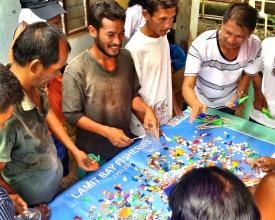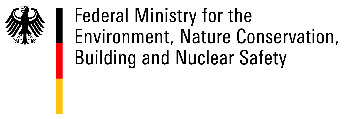
Compromiso de la comunidad y adopción de conductas en el programa Fish Forever

Para que las zonas marinas protegidas tengan éxito, la ciencia, la gobernanza y el cumplimiento de las normas deben contar con el apoyo de la comunidad. En el programa Fish Forever de Rare, las redes de reservas marinas y accesos gestionados se establecen y refuerzan utilizando enfoques probados de compromiso comunitario y adopción de conductas en cada fase del proceso. Esto ayuda a garantizar que los pescadores y las partes interesadas locales se "apropien" de la solución y se sientan motivados para mantener los esfuerzos de protección y conservación a largo plazo.
Contexto
Défis à relever
El éxito de la gestión de las AMP depende de la capacidad de abordar el conflicto percibido entre la protección y conservación de los recursos marinos y las necesidades de las comunidades en materia de alimentos y medios de subsistencia.
Ubicación
Procesar
Resumen del proceso
En el programa Fish Forever, los gobiernos locales se asocian con Rare para trabajar en pro de una pesca costera sostenible. El gobierno local asigna un equipo de ejecución de la campaña que recibe una serie de cursos de formación, entrenamiento y tutoría sobre cómo aplicar estrategias de compromiso comunitario y adopción de conductas para el establecimiento y fortalecimiento de zonas de acceso protegidas y gestionadas. Se les proporcionan diversas herramientas y recursos, que adaptan al contexto local y despliegan en el transcurso de 2-4 años.
Bloques de construcción
Formación sobre participación comunitaria y cambio de comportamiento
En una serie de talleres se forma a los equipos de las administraciones locales y otras organizaciones de apoyo sobre cómo utilizar las percepciones del comportamiento para inspirar la acción. Aprenden a utilizar la investigación cualitativa y cuantitativa para generar percepciones, enfoques participativos para llevar a la gente hacia objetivos compartidos y tácticas que ayuden a mover al grupo a través de las diferentes fases del cambio, desde la creación de la demanda colectiva hasta la coordinación del cambio y el fortalecimiento de las normas. Practican el diseño y la ejecución de sus propias actividades, desarrollan materiales y evalúan sus progresos.
Factores facilitadores
Voluntad de la unidad de gobierno local - Disponibilidad de financiación para materiales y actividades - Unidad de gobierno local bien coordinada - Personal eficiente y motivado
Lección aprendida
La formación debe ser práctica y estar al alcance conceptual de los beneficiarios previstos, los ejecutores, las comunidades y las unidades de gobierno local. Los conceptos académicos deben comunicarse de forma sencilla y comprensible para que sean apreciados. Los ejemplos prácticos y los puntos positivos son importantes. Orientar sobre los próximos pasos ayuda a garantizar la sostenibilidad de los esfuerzos a largo plazo. Fomentar la creatividad y la inventiva permitirá a las comunidades alcanzar los objetivos con un coste y un esfuerzo mínimos. Las visitas cruzadas y el intercambio de experiencias entre comunidades tienen mayor impacto que las conferencias.
Herramientas y recursos
Durante su formación, los equipos de campaña conocen una amplia gama de herramientas y recursos que pueden utilizar para desarrollar y ejecutar sus campañas de participación comunitaria y adopción de conductas. Entre ellos se incluye un marco simplificado para el cambio de comportamiento que abarca las palancas estratégicas y las tácticas que pueden aplicarse, herramientas para suscitar debates sobre las AMP y la pesca, como un juego de pesca y tarjetas con imágenes, hojas de trabajo para la planificación de campañas y plantillas para materiales de marketing social que pueden adaptarse al uso local.
Factores facilitadores
Los materiales se elaboran siguiendo un proceso de diseño centrado en el usuario para que sean fáciles de usar - Las herramientas se prototipan, prueban y actualizan periódicamente - Los usuarios tienen margen para adaptar la mayoría de las herramientas al contexto local
Lección aprendida
El objetivo es proporcionar a los equipos de campaña suficientes recursos e inspiración para que puedan llevar a cabo campañas por sí mismos. Las herramientas en sí no tienen por qué ser perfectas, ya que siempre se utilizarán de diferentes maneras. Siempre que los conceptos básicos y los resultados de una actividad estén claros, los equipos pueden tomar las directrices y hacerlas suyas.
Equipos locales de ejecución
Las campañas de compromiso comunitario y adopción de conductas fueron desarrolladas y ejecutadas por equipos con base en las comunidades. Normalmente estaban formados por personal de la unidad de gobierno local y líderes comunitarios locales, como dirigentes de pescadores u organizadores. Fueron ellos quienes recibieron la formación y a quienes se proporcionaron las herramientas y los recursos. Adaptaron las estrategias a su propio contexto, propusieron ideas de ejecución y pusieron en marcha las actividades.
Factores facilitadores
Designación oficial por el jefe del ejecutivo local (alcalde) - Representación de partes interesadas distintas del gobierno local - Credibilidad y prestigio en la comunidad
Lección aprendida
Lo mejor es contar con un equipo de al menos tres personas, para que el trabajo no resulte abrumador y para que el equipo disponga de diversos talentos e intereses. La combinación ideal incluye a alguien que esté bien integrado en el gobierno, que pueda conseguir aprobaciones y presupuestos, alguien que sea creativo y capaz de utilizar herramientas básicas de diseño, y alguien que esté bien aceptado por la comunidad y que sepa cómo implicar y facilitar. Todos ellos deberían saber cómo movilizar voluntarios y tener algunas habilidades básicas en la gestión de proyectos.
Impactos
En 20 lugares de Filipinas se registraron mejoras significativas en parámetros sociales como el aumento de la participación, la confianza y la cohesión, cambios positivos en los conocimientos y actitudes, y una disminución de las infracciones. Los estudios realizados en el agua en estos lugares también mostraron aumentos en la abundancia de peces y la biomasa dentro y fuera de las zonas de prohibición de pesca, especialmente en los lugares que habían mantenido sus campañas de participación comunitaria durante más de 4 años.
Beneficiarios
Gobiernos locales y organizaciones comunitarias, dirigentes pesqueros y, en última instancia, los pescadores y sus comunidades.
Objetivos de Desarrollo Sostenible
Historia

Durante décadas, la pesca con dinamita en Bindoy estuvo muy extendida y fue intergeneracional, incluso rutinaria. Edgar Torres, un pescador, relata: "No me asustaba la pesca con dinamita porque cogíamos mucho pescado. Sacos de pescado".
En 1998, el alcalde Valente Yap sabía que tenía que hacer algo. El arrecife llevaba años sufriendo el azote de la pesca ilegal, y a él le preocupaban las repercusiones en la seguridad alimentaria y laboral de la zona. Durante las dos décadas siguientes, ésta fue su misión.
En primer lugar, trabajó para convencer a los pescadores locales de que aceptaran la declaración de una zona marina protegida (ZMP). Al principio, los pescadores protestaron contra la idea por miedo al impacto a corto plazo del cierre del acceso al rebosante arrecife de Mantalip. Entonces reforzó el equipo local encargado de hacer cumplir la ley para perseguir a los pescadores ilegales con métodos como la dinamita y el cianuro.
El alcalde Yap y el gobierno municipal también se propusieron cambiar la actitud hacia la pesca ilegal, no avergonzando el comportamiento ilegal, sino creando una ética de conservación en toda la comunidad. En 2012, Bindoy se asoció con Rare para llevar a cabo una campaña Rare Pride de pesca sostenible, con el objetivo de inspirar a la comunidad para que pasara de centrarse en las ganancias a corto plazo a centrarse en los beneficios a largo plazo de los comportamientos sostenibles.
Richard Balauro, funcionario del gobierno municipal, dirigió la campaña del Orgullo de Bindoy. Richard y su equipo organizaron actos participativos y talleres con organizaciones populares, colocaron vallas publicitarias y suscitaron conversaciones. Organizaron actos como el Día de los Pescadores y el Festival Libod Sayaw, donde los habitantes conocieron a la mascota del Orgullo de Bindoy, Lovie, un pargo de manchas negras, la especie que se encuentra en el arrecife Mantalip.
El alcalde Yap afirma que el compromiso de la comunidad fue esencial para la transformación de Bindoy. "No podemos aplicar la ley y todos estos programas para el medio ambiente sin el apoyo de las organizaciones populares", afirma. "El marketing social de Rare pudo ayudarnos a cambiar la mentalidad de nuestros pescadores y de la gente de los barangays costeros, y [mostrarles] que lo que estamos haciendo es por su bienestar".
La campaña ayudó a pescadores como Edgar Torres a comprender cómo debía cambiar su relación con el medio marino. "Cuando se propuso declarar Mantalip zona protegida, yo me opuse", dice. "Pensaba, como pescador, ¿dónde íbamos a pescar? La campaña Pride me convenció para cambiar de opinión. Me centré en el futuro de mi familia. Ese se convirtió en mi objetivo, pescar de forma responsable para que mis hijos tuvieran un mañana mejor".






